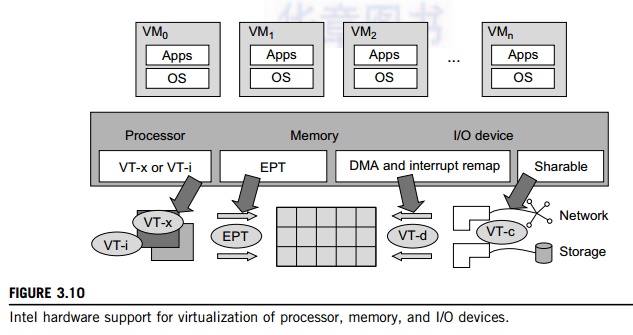Chapter: Distributed and Cloud Computing: From Parallel Processing to the Internet of Things : Virtual Machines and Virtualization of Clusters and Data Centers
Hardware Support for Virtualization
Hardware Support for Virtualization
Modern operating systems and processors permit multiple processes to run simultaneously. If there is no protection mechanism in a processor, all instructions from different processes will access the hardware directly and cause a system crash. Therefore, all processors have at least two modes, user mode and supervisor mode, to ensure controlled access of critical hardware. Instructions running in supervisor mode are called privileged instructions. Other instructions are unprivileged instructions. In a virtualized environment, it is more difficult to make OSes and applications run correctly because there are more layers in the machine stack. Example 3.4 discusses Intel’s hardware support approach.
At the time of this writing, many hardware virtualization products were available. The VMware Workstation is a VM software suite for x86 and x86-64 computers. This software suite allows users to set up multiple x86 and x86-64 virtual computers and to use one or more of these VMs simultaneously with the host operating system. The VMware Workstation assumes the host-based virtualization. Xen is a hypervisor for use in IA-32, x86-64, Itanium, and PowerPC 970 hosts. Actually, Xen modifies Linux as the lowest and most privileged layer, or a hypervisor.
One or more guest OS can run on top of the hypervisor. KVM (Kernel-based Virtual Machine) is a Linux kernel virtualization infrastructure. KVM can support hardware-assisted virtualization and paravirtualization by using the Intel VT-x or AMD-v and VirtIO framework, respectively. The VirtIO framework includes a paravirtual Ethernet card, a disk I/O controller, a balloon device for adjusting guest memory usage, and a VGA graphics interface using VMware drivers.
Example 3.4 Hardware Support for Virtualization in the Intel x86 Processor
Since software-based virtualization techniques are complicated and incur performance overhead, Intel provides a hardware-assist technique to make virtualization easy and improve performance. Figure 3.10 provides an overview of Intel’s full virtualization techniques. For processor virtualization, Intel offers the VT-x or VT-i technique. VT-x adds a privileged mode (VMX Root Mode) and some instructions to processors. This enhancement traps all sensitive instructions in the VMM automatically. For memory virtualization, Intel offers the EPT, which translates the virtual address to the machine’s physical addresses to improve performance. For I/O virtualization, Intel implements VT-d and VT-c to support this.

Related Topics